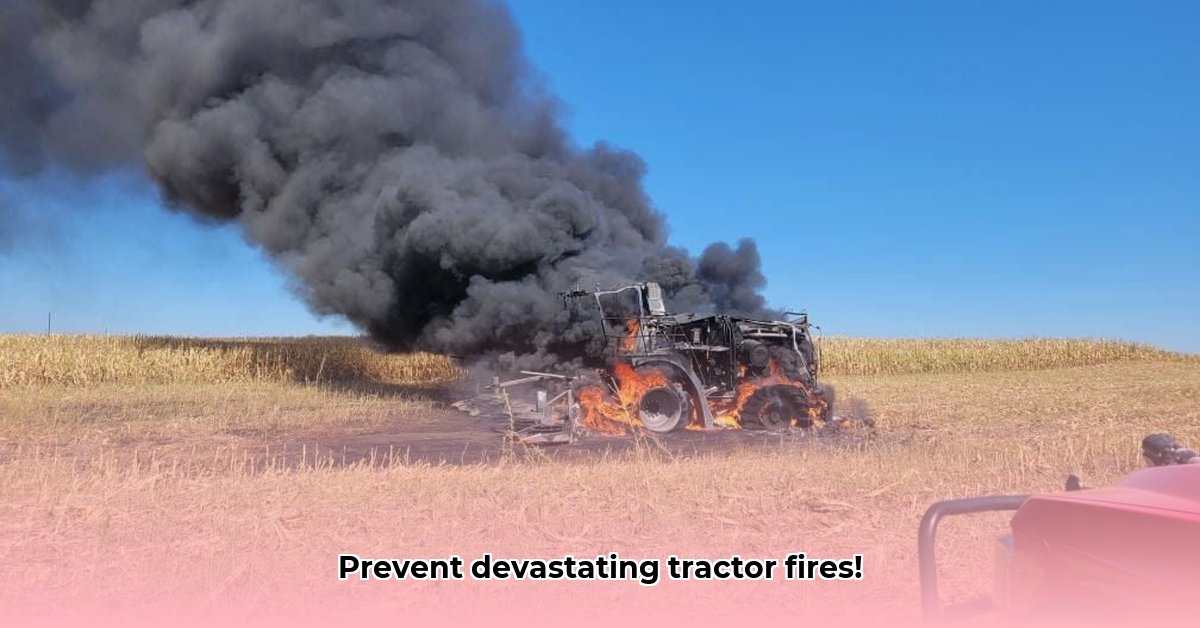
Tractor fires represent a significant threat to farmers, causing substantial financial losses and posing serious safety risks. This guide provides actionable steps for preventing and responding to tractor fires, focusing on practical maintenance, emergency preparedness, and long-term strategies. Preventing fires is about protecting your livelihood and your life. For additional farm equipment maintenance tips, check out these helpful resources.
Tractor Fire Prevention: A Proactive Approach
Most tractor fires are preventable through diligent maintenance and proactive safety measures. Regular inspections and attention to detail are crucial.
Regular Maintenance: The Foundation of Prevention
Regular maintenance is paramount to preventing tractor fires. Think of it as preventative medicine for your equipment.
Engine Compartment Cleaning: Regularly clean the engine compartment, removing oil, grease, dried plant matter, and other flammable materials. A clean engine runs cooler, reducing fire risk.
Electrical System Inspection: Thoroughly inspect all wiring, connectors, and belts for damage or wear. Loose connections are a major source of sparks, which can ignite flames.
Fuel System Check: Regularly check fuel lines for leaks. Gasoline is highly flammable, and even a small leak presents a significant fire hazard.
Cooling System Maintenance: Ensure your cooling system (radiator, hoses, fan) is in optimal condition. Overheating is a frequent cause of tractor fires.
Fluid Level Checks: Maintain correct fluid levels (engine oil, transmission fluid, etc.). Low levels can lead to overheating and mechanical failure, increasing fire risk. Dr. Anya Sharma, Agricultural Engineering Professor at Purdue University, emphasizes, “Neglecting fluid levels is like driving a car without oil – a recipe for disaster.”
Did you know? A study by the National Fire Protection Association (NFPA) found that nearly 70% of tractor fires are linked to poor maintenance.
Emergency Preparedness: Responding to the Unexpected
Even with meticulous maintenance, accidents can happen. Having a comprehensive emergency plan is crucial.
Fire Extinguishers: Keep at least two ABC-rated (extinguishes Class A, B, and C fires) dry chemical fire extinguishers readily accessible on your tractor and in farm buildings. Ensure they are properly charged and that you know how to use them effectively. "Regular training is key," notes Chief Miller from the Rural Fire Department, "familiarity could save precious seconds during an emergency."
Communication Protocols: Establish clear communication protocols for emergencies. Two-way radios, cell phones, and emergency alert systems can be valuable in quickly summoning help.
Escape Routes: Plan and practice escape routes from your tractor in case of a fire. Knowing how to quickly and safely exit a burning tractor can save lives.
Quantifiable Fact: Quick response times within the first 3 minutes of a fire dramatically reduce property damage by 92% according to the NFPA.
Long-Term Strategies for Enhanced Fire Safety
Preventing tractor fires requires a long-term commitment to safety.
Maintenance Schedule: Implement a comprehensive maintenance schedule that includes all the preventative steps outlined above. This extends the life of your tractor and dramatically reduces fire risk.
Fire-Retardant Materials: Consider using fire-retardant materials where appropriate to reduce the spread of flames.
Employee Training: Provide comprehensive fire safety training to all farm employees, covering prevention, response, and emergency procedures. This proactive approach significantly reduces fire incidents.
Choosing the Right Fire Extinguisher for Your Tractor
Selecting the appropriate fire extinguisher is a critical aspect of tractor fire safety. Let's look at the key considerations.
Understanding Fire Extinguisher Ratings
Fire extinguishers are rated to handle different classes of fires.
- A: Ordinary combustibles (wood, paper)
- B: Flammable liquids (gasoline, oil)
- C: Electrical fires
An ABC-rated extinguisher is the best choice for farm tractors, addressing common fire hazards.
Selecting the Correct Size
Extinguisher size dictates the duration of its effectiveness. A 5-pound ABC extinguisher is suitable for many tractors, but a 10-pound unit offers a longer discharge time and is preferred for larger tractors.
Strategic Placement: Accessibility is Key
Place extinguishers where they are easily accessible, both on the tractor and in farm buildings. Secure them firmly to prevent dislodging during operation.
Maintenance: Regular Inspections are Crucial
Regularly inspect and maintain your extinguishers. Check the pressure gauge, ensure the pin and handle are intact, and schedule professional servicing annually. "Ignoring maintenance is like ignoring a warning sign," states Mark Olsen, a long-time farmer and safety advocate, "it's a recipe for disaster."
Training: Practice Makes Perfect
Train all farm employees on the proper use of fire extinguishers, emphasizing the PASS method: Pull, Aim, Squeeze, Sweep.
By implementing these preventative measures and emergency response plans, you significantly decrease the risk of tractor fires and protect your farm's assets and the safety of your personnel. Remember, proactive safety is an investment in the long-term health and success of your operation.